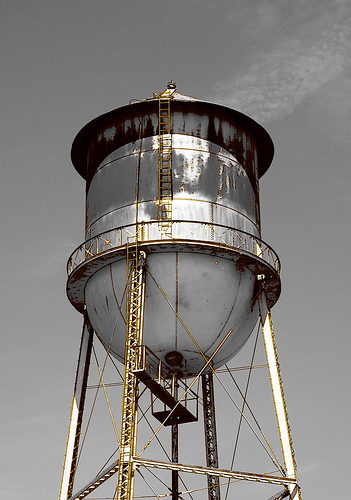 Our nation’s water infrastructure faces real and immediate challenges.Photo: Kevin DooleyBlog Action Day is an annual event held every October 15 that unites the world’s bloggers in posting about the same issue on the same day with the aim of sparking a global discussion and driving collective action. This year’s topic is water.
Our nation’s water infrastructure faces real and immediate challenges.Photo: Kevin DooleyBlog Action Day is an annual event held every October 15 that unites the world’s bloggers in posting about the same issue on the same day with the aim of sparking a global discussion and driving collective action. This year’s topic is water.
I don’t remember how old I was when I learned that water is not supposed to have a taste. I grew up in a town that was surrounded by oil refineries and heavy industry, basically learning that water that tasted like chemicals and metals was normal. This was my reality, and unfortunately the reality for many young people growing up in low income communities and communities of color. The EPA estimates that more than 870,000 of the 1.9 million housing units for the poor, occupied mostly by Latino and African Americans, sit within approximately a mile of factories that report toxic emissions to the U.S.
Turning on your faucet shouldn’t be a high-risk venture. Parents shouldn’t have to worry whether or not the water in their homes is safe for their children to drink. Cities and towns shouldn’t have to worry that the water lost in leaky pipes will mean ongoing shortages or usage restrictions. But these concerns are already cropping up in communities throughout the country — and they will only become more common as decades of neglect to our water infrastructure begin to catch up with us.
We have a choice: We can either be a country that continues to take shortcuts for the benefit of polluters, or we could be a country that sees opportunity in water. With the proper investment in our infrastructure, we can conserve water, decrease greenhouse gas emissions, upgrade its integrity, generate revenue for cities, and create green jobs and new green spaces in low income communities and communities of color.
We’ve seen some of the sorts of innovation that illustrate what’s possible.
Green For All academy fellow Katie Houstoun spearheads a program in Philadelphia aiming to turn one-third of the city’s impervious asphalt surface into absorptive green spaces. The city has even declared that all new buildings must capture the first inch of water on-site. One inch of rainwater hitting one acre of asphalt means 27,000 gallons of water going into the sewer. “For a big warehouse downtown with lots of parking spaces, they could be looking at half a million in storm water fees per year,” says Houstoun.
Edmonston, Md., used more than $1 million in funds from the American Recovery and Reinvestment Act to transform its main street from a flood-prone hazard to a “green street” that diverts storm water to keep it from overflowing and polluting the Anacostia River. This green infrastructure project generated about 50 jobs for local companies.
Treepeople, in Los Angeles, retrofitted a public park and built a 216,000 gallon underground cistern to capture and reuse rainwater for use in dry months, when the park vegetation must be irrigated to survive. The purpose of this green infrastructure is to mitigate the city’s need to import 85 percent of its usable water — and to save the city money. As an additional benefit, tree canopies from strategically planted trees can also help cool the environment up to 10 degrees F to counter heat-trapping concrete, which in turn saves families money in energy bills.
Innovation exists. And it must be expanded, explored, and invested in. The challenges our nation’s water infrastructure faces are real and immediate, and the existing problems, particularly in low-income communities, are long-standing and increasingly severe.
We often speak of creating a better life for our children. I know how our water systems failed my community when I was a kid. Working together, we can ensure that future generations ensure that America is green — but that our water is clear.




